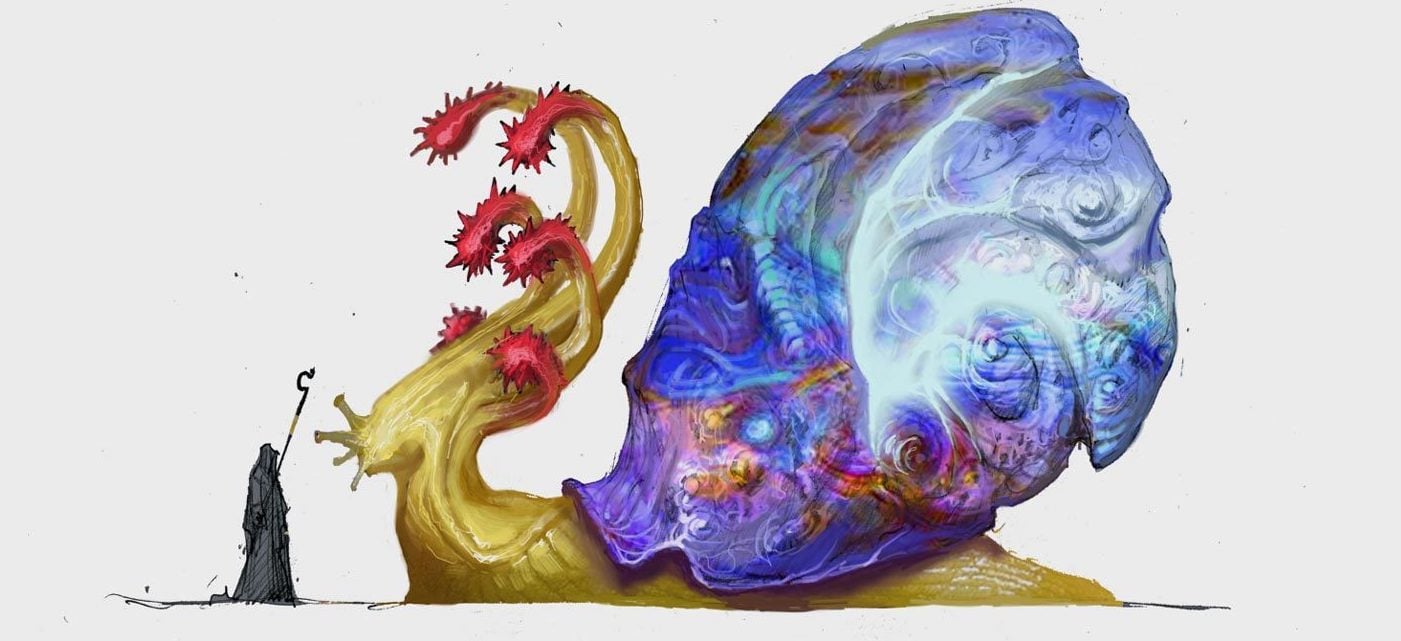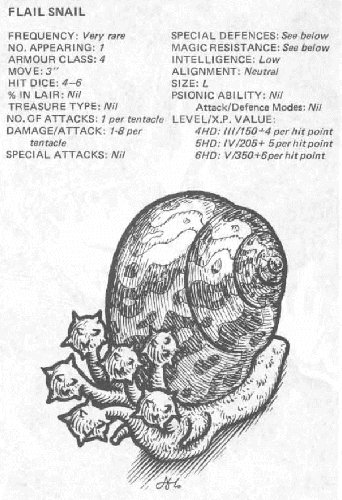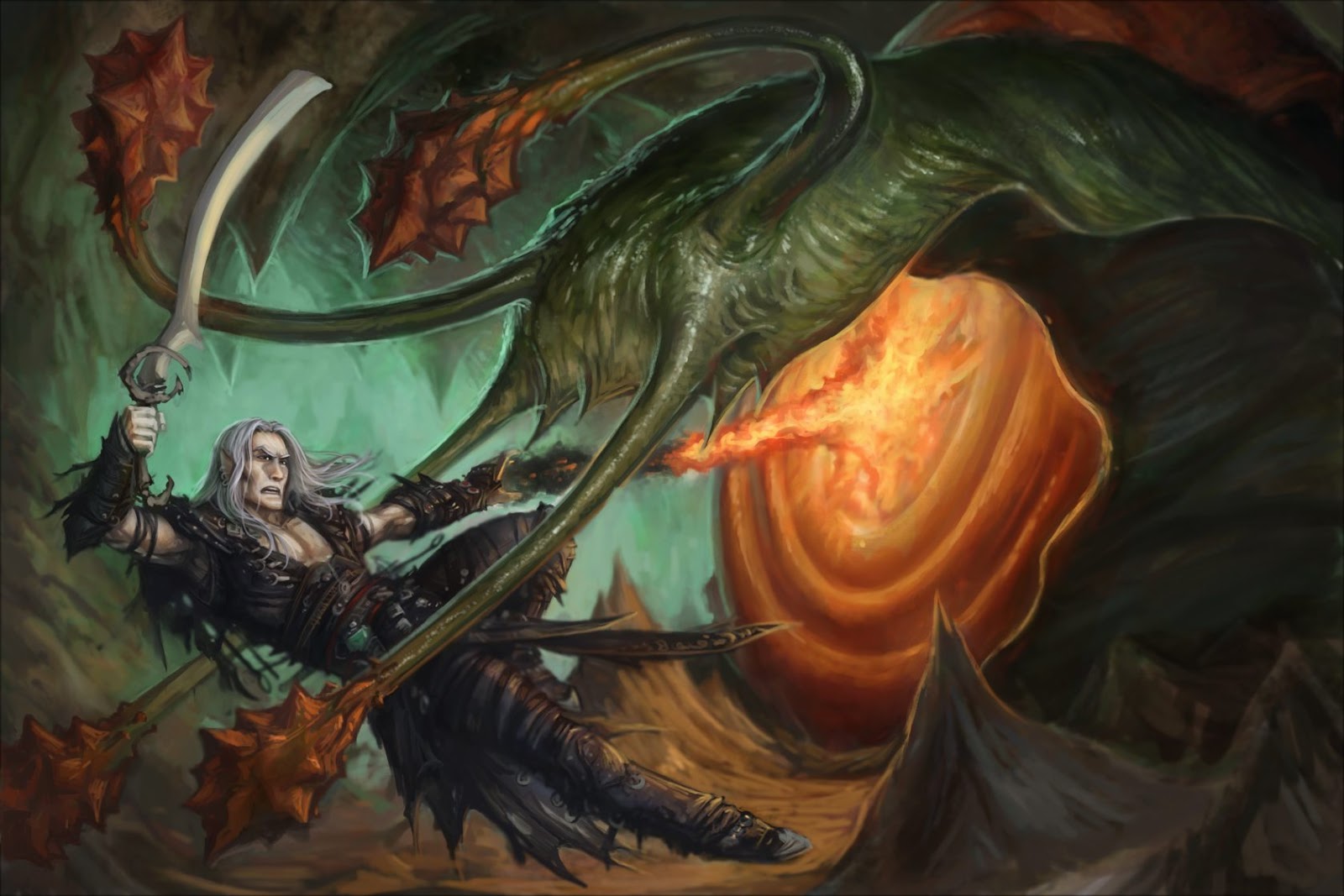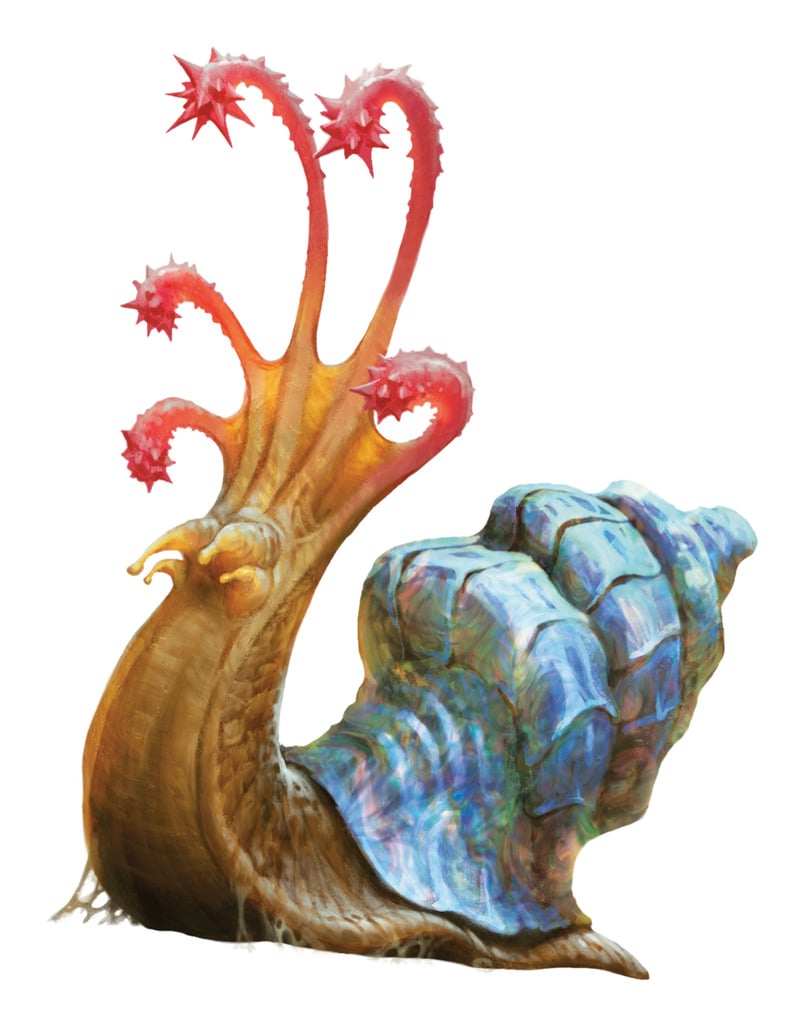Monster Spotlight: The Flail Snail – Power To The Shell

The Flail Snail eats mostly grail kale and makes a mighty fine pale ale.
Today we were going to be boarding the BoLS Galleon and taking that fine ship to the home terrain of our monster of the week this week–but we realized that it has had a malfunction with its primary motive method, and the wooden ‘ribs’ on the ship splintered. Made the whole journey this daunting arduous prospect. So instead, we’ve jumped ship and gone down to the local market, where we’ve made do with the discounted goods being offered by an albino gastropod–buckets primarily. Fortunately, we were able to find an astonishing, second gastropodal monster inside, this one armed with multiple, club-like heads. In other words:
Failed sail/wale travail. Bailed, availed pale snail’s pail sale–unveiled Flail Snail.
Now try saying that three times fast. And while you’re doing that, take a look at what is quite possibly the best monster in the entire catalogue of D&D Entries from throughout the years. It comes from none other than the Fiend Folio, which is the book where they sat down and decided, “you know what? Let’s just do a whole bunch of really weird stuff and see what sticks.” The same book that’s generated a rogue’s gallery of memorable monsters, famous fiends, and curious creatures. If you’ve ever run into a Flumph, a Gith(yanki or zerai), a Denzelian…
…a Doombat, a Disenchanter (sort of like an anteater for magic items), a Garbug, a Slaad, or a Symbiotic Jelly, you’ve had a run-in with the treasure trove of strange greatness that is the Fiend Folio. And in the spirit of this most delightful of books, we’ve found a monster that encapsulates the spirit of the book and the game: the Flail Snail. This is one of those monsters that has endured throughout the editions–it started with the Fiend Folio and then was included in the Greyhawk portion of the Monstrous Compendium in second edition, and by that time it had flailed its way into the hearts of millions. Or at least three other people.
In 3rd Edition it saw new life with the advent of Pathfinder, appearing in Bestiary 3, and a triumphant return as the star of Volo’s Guide to Monsters. Check it out in all its glory, from its humble origins as a magical creature whose magical shell was much sought-after to the dazzling delight it is today.
1st Edition Flail Snails appeared in the Fiend Folio, as we mentioned. There they had a decent suite of attacks. These things were monstrous, eight feet tall with 4-6 club tentacles it could use to make an attack. This was a complicated monster to run–each flail snail’s snail flail had it’s own hit points, so when a flail snail’s snail flail failed, it ceased to be. The number of club tentacles corresponded to the amount of hit dice that it had, and each one was difficult enough to hit. Attacks on the snail itself had an effective -8 AC, the AC 4 you see above represents the AC of a tentacle.
In addition it had a number of special defenses, including native fire and poison immunity, and its highly-colored, magical shell. This shell is the source of is magical protection–acting as a robe of scintillating colors that gives spells targeting the Flail Snail a 40% chance to malfunction, a 30% chance to function normally, a 20% chance of outright failing, and a 10% chance of being reflected back at the caster. And this was back in the day when monsters were routinely butchered for their parts, so its shell is super valuable, retaining its magical properties for up to six months, and netting a canny adventurer about 5,000 gp.
However, it takes a real monster to go through with the simple act of killing one of these beautiful creatures. Their real defense happens when you realize that you’ve nearly killed one. After all of its club tentacles have been killed, the Flail Snail withdraws back into its shell and starts uttering pitiful, wailing cries until it DIES 1-3 turns later. And each of its pathetic, mournful, fear-filled wails has a 50% chance of attracting a wandering monster (because these were also the days when DMs hated their players and saw them as the enemy–which to be fair, they are). Yeah think about that–can’t help but feel like you wanna keep it safe.
In 2nd Edition, the Flail Snail took on a slightly more realistic look. You can really see the patterns in the shell there. And, much like its earlier counterpart, it still has the same X tentacles where X is the number of hit dice it has–but in 2nd edition facing also came into play, and the Flail Snail could only attack opponents to the front and side of it. They also got a little bit more detail–they are outfitted with some motion-sensing organs that have a 20-foot range, for one. We also get a little more of the ecology of these creatures. They eat lichen and algae and have mouth glands that secrete an enzyme that loosens the plants. And they have families–young Flail Snails remain with their mother until their flails are big and heavy enough to go out into the big, scary world all on their own.
And you know they might get hurt out there. But they might also find joy. And that’s life–life is not knowing. Life is hoping for that moment of beauty but then also waking up in the middle of the night when your Flail Snail offspring is emitting its death wails and you wonder, why existence has to be so tortured and cruel–but across town, another set of Flail Snails are working hard and helping your other (because you’ve had 1d3 offspring) child reach its full potential–and it changes the world. For the better.
Also their shells are still worth 5,000 gp, but now adventurers can fashion 1-2 +2 shields from a single shell, or it can be ground into the needed components to create a robe of scintillating colors.
The Flail Snail continued to live on in the hearts and minds of gamers, even if it didn’t appear in the 3rd edition monster manuals. It wasn’t until the advent of Pathfinder that it saw a return to the gaming table. Perhaps the Flail Snail was slightly off-brand for 3rd Edition’s less adventury, slightly grittier tone. At any rate, they had a resurgence in the Bestiary 3 (which is one of the strongest contenders for Best of the Bestiary, but that’s another matter entirely). At any rate, the Pathfinder Flail Snail saw a drop in effectiveness, weighing in at only CR 4. It had 4d10_8 hit points and a pretty beefy AC of 18 (though by the time the Bestiary 3 came out, level 1 characters didn’t have a problem hitting AC 18, so take that what you will).
Like its predecessors, it could withdraw into its shell to protect itself, taking a swift action to increase its natural armor bonus by +6, though it couldn’t move or attack while retracted. It also exuded a trail of mucus that could be either slimy or sticky. Sticky changed terrain into difficult terrain, slippery mucus functioned like a discount grease spell. These Flail Snails ALSO gained the ability to shoot out a slime rope, which let them hang suspended from what ever it wanted, and up to 1,000 extra pounds of material. So they could adhere to a ceiling or wall and lay in ambush.
Also, the magical resistance of their shell was altered–spells targeting these Flail Snails had an 80% chance to malfunction, with the spell either misfiring and making it harder for the caster to cast spells, the spell getting retargeted, it just fizzling, or being reflected depending on the roll of a d10. This is a significant boost–there’s no chance that the spell works as normal once its protective shell is triggered. The best part is, if you had a pack of Flail Snails, you could see spells warp along the Flail Snail Trail and it would have much better chance of being negated. Also, it no longer withdraws into its shell and contemplates its own mortality when all of its tentacles are slain, which is a plus.
Finally there’s the 5th Edition Flail Snail. Whose rainbow-hued shell is very fetching. Although curiously, I like the concept art much better than the finalized version. Take a look at what the Flail Snail might have looked like, according to Dragon +:
There’s galaxies and nebulae spiraling in that shimmering shell. Also it looks slimier and more vibrant somehow. At any rate, here’s how they work.
They are much the same as their antecedents, harboring an anti-magic shell for its protection. It reduces the chances that some kind of mishap will occur, though it does grant the Flail Snail advantage on saving throws and disadvantage to anyone making spell attacks against it. And on a 1-2 the spell is reflected back or negated, 3-4 it works normally, and 5-6 grants it some kind of destructive burst, which is amazing. So these majestic creatures can literally burst with magical power. They also gain the ability to channel their dazzling light into a concentrated burst, stunning enemies caught unaware.
But this power comes with a terrible price. Any time it takes more than 10 damage, one of its tentacles dies–resulting in a much longer death wailing process, with it taking 5d6 minutes to expire once it withdraws into its shells to die. Though it does regenerate if it has even one tentacle left at the end of an encounter.
And there you have it. An exemplary part of the weird, fantastical world of D&D. And with the advent of things like Volo’s Guide and the Tomb of Annihilation, we’re seeing a return to these sorts of things, which I think is great. This has been missing from D&D for the last little while, and it’s cool to see this imaginative spirit embraced.
Flail Snail’s Snail Flail flails snails, fails to flail flail snails, flail snails flailing flail snails need Flail Snail’s Flail Snail Flails.










